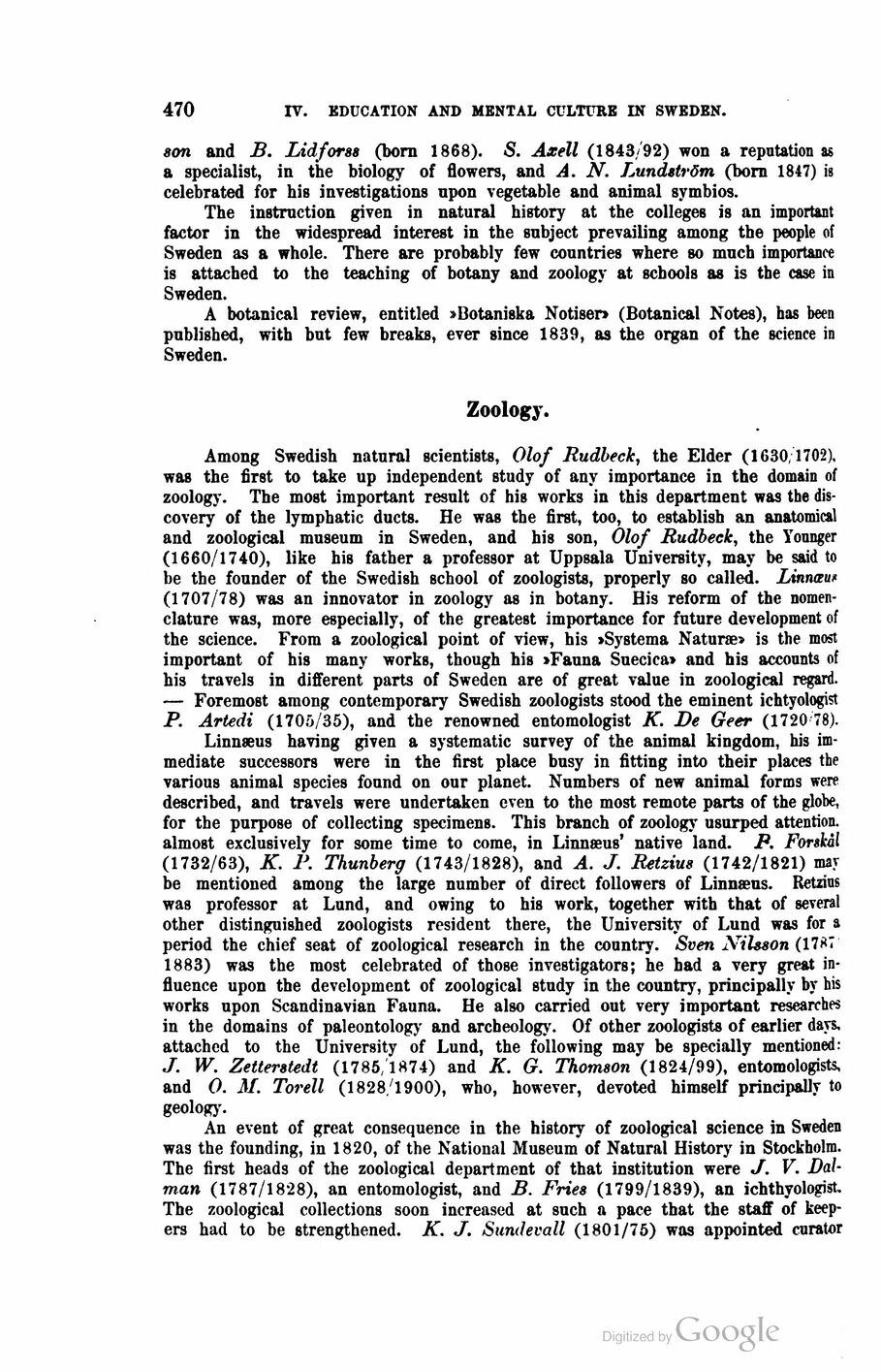
Full resolution (JPEG) - On this page / på denna sida - First part - IV. Education and Mental Culture - 10. Science - Botany, by H. Hesselman, Ph. D., Stockholm - Zoology, by Hj. Östergren, Ph. D., Uppsala

<< prev. page << föreg. sida << >> nästa sida >> next page >>
Below is the raw OCR text
from the above scanned image.
Do you see an error? Proofread the page now!
Här nedan syns maskintolkade texten från faksimilbilden ovan.
Ser du något fel? Korrekturläs sidan nu!
This page has never been proofread. / Denna sida har aldrig korrekturlästs.
470
IV. EDUCATION AND MENTAL CULTURE IN SWEDEN.
son and B. Lidforss (born 1868). S. Axell (1843/92) won a reputation as
a specialist, in the biology of flowers, and A. N. Lundström (born 1847) is
celebrated for his investigations upon vegetable and animal symbios.
The instruction given in natural history at the colleges is an important
factor in the widespread interest in the subject prevailing among the people of
Sweden as a whole. There are probably few countries where so much importance
is attached to the teaching of botany and zoology at schools as is the case in
Sweden.
A botanical review, entitled »Botaniska Notiser» (Botanical Notes), has been
published, with but few breaks, ever since 1839, as the organ of the science in
Sweden.
Zoology.
Among Swedish natural scientists, Olof Rudbeck, the Elder (1630; 1702).
was the first to take up independent study of any importance in the domain of
zoology. The most important result of his works in this department was the
discovery of the lymphatic ducts. He was the first, too, to establish an anatomical
and zoological museum in Sweden, and his son, Olof Rudbeck, the Younger
(1660/1740), like his father a professor at Uppsala University, may be said to
be the founder of the Swedish school of zoologists, properly so called. Linnceu*
(1707/78) was an innovator in zoology as in botany. His reform of the
nomenclature was, more especially, of the greatest importance for future development of
the science. From a zoological point of view, his »Systema Naturæ» is the most
important of his many works, though his »Fauna Suecica» and his accounts of
his travels in different parts of Sweden are of great value in zoological regard.
— Foremost among contemporary Swedish zoologists stood the eminent ichtyologist
P. Artedi (1705/35), and the renowned entomologist K. De Geer (1720 78).
Linnaeus having given a systematic survey of the animal kingdom, his
immediate successors were in the first place busy in fitting into their places the
various animal species found on our planet. Numbers of new animal forms were
described, and travels were undertaken even to the most remote parts of the globe,
for the purpose of collecting specimens. This branch of zoology usurped attention,
almost exclusively for some time to come, in Linnaeus’ native land. P. Forsiàl
(1732/63), K. P. Thunberg (1743/1828), and A. J. Retzius (1742/1821) mar
be mentioned among the large number of direct followers of Linnaeus. Retzius
was professor at Lund, and owing to his work, together with that of several
other distinguished zoologists resident there, the University of Lund was for a
period the chief seat of zoological research in the country. Sven Nilsson (17*7
1883) was the most celebrated of those investigators; he had a very great
influence upon the development of zoological study in the country, principally by his
works upon Scandinavian Fauna. He also carried out very important researches
in the domains of paleontology and archeology. Of other zoologists of earlier days,
attached to the University of Lund, the following may be specially mentioned:
J. W. Zetterstedt (1785,1874) and K. G. Thomson (1824/99), entomologists,
and O. M. Torell (1828/1900), who, however, devoted himself principally to
geolog}-.
An event of great consequence in the history of zoological science in Sweden
was the founding, in 1820, of the National Museum of Natural History in Stockholm.
The first heads of the zoological department of that institution were J. V.
Dalman (1787/1828), an entomologist, and B. Fries (1799/1839), an ichthyologist.
The zoological collections soon increased at such a pace that the staff of
keepers had to be strengthened. K. J. Sundevall (1801/75) was appointed curator
<< prev. page << föreg. sida << >> nästa sida >> next page >>